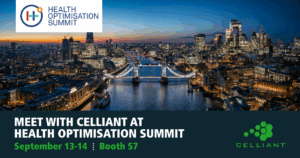Entering the professional workforce, I initially wanted to be in entertainment and was ecstatic when I landed a job as an associate producer. The hours required were really quite difficult with over twelve hours every day; there were no benefits and no time off as I was technically part-time. There was just no plan, or concern really, for the wellbeing of anyone that worked there. At the time I thought this is what was needed to “make it” through the beginning, and for people to see my value. But after leaving I realized that lifestyle is not sustainable, that’s not what’s needed, and your value should already be established. Now I would only consider a job where wellbeing is a part of the ethos of the company, as it is at Hologenix.
Wellness, to me, means our employees are feeling psychologically safe and physically comfortable at work. That includes freedom to express ideas and collaborate knowing your ideas are valued and valuable. It is important that there is also safety in being able to express the difficulties you’re having (whether professionally or personally) and what you need — whether that is an extension, assistance, etc. At Hologenix, there’s a real comfort and understanding that we are merely human and at some point, a life event will occur where we may need grace extended to us in the workplace. We have fostered an environment where there’s no judgment or issue with expressing where you’re at and being provided what you need.
Hologenix is a smaller company, which gives us the fortune of being able to engage with each other more intimately. We have a weekly Monday all-team meeting where we talk about how we’re doing, get to know each other better, and discuss any challenges we’re facing with our upcoming week. Every week we pull a card at random with a question which can often lead to pretty deep conversations, which, in turn, strengthens team bonds. The point is that Hologenix gives us the time and space to really check-in with one another and get to know each other on a level beyond just what our role at the company is.
We also have company-sponsored, optional social outings once a month and I think the consistent attendance we have at those, plus the amount of fun we have, is one other barometer of how people are doing.
Due to our size, we are not necessarily using analytic tools and research to gauge productivity. However, we do know our methods are working when we assess our results. For the last consecutive 5 years we have had impressive growth as a company, even being recognized on the INC 5000 Fastest Growing Companies list several times. From personal experience, we know that work performance suffers when our life outside of work is in chaos. We have a largely remote workforce and I think that by the company’s leadership showing the trust in everyone to accomplish what’s needed within a flexible model, not only in terms of where you work, but when you work, leads to increased satisfaction and productivity.
An important thing employers need to recognize is that people are increasingly looking for wellbeing in their job, and they are willing to leave in order to find it. Historically there were certain wellness benefits employees saw as ‘nice-to-haves’ but now they are table stakes. If we’d like to speak in terms of ROI, it’s far more costly to replace a person who leaves (because they aren’t finding wellness in their job) than it is to invest in the person’s wellbeing.
According to HR professionals, there’s been lots of talk about the ‘great resignation’ here in the US, but they are now warning employers that it’s not so much a trend and that they should think of it as a sustained resignation.
At the end of the day, we’re all human and these times are particularly challenging, so people should expect their employers to really care about them as people.
When you’re interviewing candidates they all want to know what the culture at the company is. You have to think of it, not only as you interviewing the talent but the talent interviewing you. So we let every candidate know about our Monday all-team meetings that I mentioned previously, our monthly company outings, and the supportive culture here at Hologenix. We also have a comprehensive benefits package, including great health insurance options, and added wellbeing perks — a small example being pet insurance. It’s just one way to not only help people, but to really have people understand that we care about them as a whole person. For financial wellbeing, we’ve also recently started a 401k program with company match, which is quite rare for a company our size.
I believe mental wellness is all about creating a safe space so every person is valued and empowered to express any difficulties, either professionally or personally. It negates an organizational hierarchy when it comes to employees contributing ideas and enforces the notion that we all have great things to offer the team (no matter the person’s role).
We strive to create an environment where mental health and mental illness are part of the conversation, with respect to individual boundaries. We also believe in empowering our employees to increase their skill sets and keep their intellectual toolkits sharp by sponsoring our employees to engage in supplemental classes, lessons, etc.
Hologenix observes all federal holidays in addition to closing our office for two weeks — a mid-year summer break and a year-end winter break which is appreciated. We call them wellness weeks because it’s easier to truly disconnect during this time when the whole company is off.
For social wellness, I revert to our monthly (optional) company-sponsored outings where we do something fun or informative and have a great time as a whole team. Depending on the activity, sometimes we’ll even include our significant others. Examples include food tastings, escape rooms, theater events, and more. We also celebrate work anniversaries, birthdays and team member milestones.
Physical wellness is the DNA of Hologenix given our CEO and co-founder, Seth Casden, has an extensive athletic background. Our flagship technology CELLIANT® enhances physical wellness through infrared energy and is used by many brands in the athletic and active apparel spaces.
I’m particularly excited about the expansion of our business and the evolution of my role; building out our FemTech product offerings to women consumers. So, not only is physical wellness part of our internal ethos, but it also drives our external goals as a company.
Right now there’s excitement around our newly instated 401k retirement offering — there is a generous company match for a company our size.
These areas of wellness culminate with our generous maternity and paternity leave benefits which are well beyond the federal and state minimums. Our company leadership really felt that it was necessary to protect the time that our employees get with their newborns. It is a very family friendly environment.
When it comes to wellness and the wellbeing of employees, there’s really no one-size-fits-all approach. I believe employers need to take into account their workers’ needs and wants which are different company to company and industry to industry. The key is ensuring their needs are met. It is important to be willing to adapt and learn from your workforce.
I think small steps can be big things and make a big difference. Not everything that’s geared toward employee wellbeing has to be expensive or difficult — really, you just have to be committed to it. And that’s key. We should be thinking of wellbeing initiatives as not only important but also as long-term and as being built right into the foundation of doing business. While there are many trends related to wellness at work, we need to think of these as permanent fixtures rather than temporary trends.
Mental health benefits have to be at the top of any wellness program for organizations; especially with the disruption to society that COVID-19 pandemic caused. There has collectively been a conscious shift with employees: an evolution of determining what role work should play in our lives and an awareness of mental health issues that plague us.
As a result, this consciousness is reducing stigma, an important first step, but people still need meaningful access to mental health support services. The best way is through mental health benefits (or a stipend) being added to an organization’s benefits package. Data supports the correlation between mental health issues and a range of productivity issues like absenteeism, lack of participation in meetings, and so on.
This goes hand in hand with mental health benefits above. I’m particularly drawn to the trend of stress management and resilience. This is about giving employees access to tools that will help them manage their stress. This could look like free subscriptions to fitness, nutrition and meditation apps that they will find useful and bring a greater sense of wellbeing to them personally. Of course along with access, the organization has to provide the time and space to use these self-care methods.
Another important wellness trend to be looking at is employers taking into account the whole person and not just typical health benefits. So, it’s the idea of providing perks that help employees navigate all aspects of their life from financial planning and legal aid to support for major life events, no matter what stage of their life they’re in. Some companies offer flex holidays where employees are free to observe the holidays or cultural significances that are important to them, even if the entire company is not observing it. This is just one example of trying to personalize offerings to make employees feel individually valued and understood.
One key trend that’s very close to my heart is adaptive workplace design. Employers need to look at the spaces they are creating and how those spaces can better serve their employees from a health and wellness perspective. Our flagship product, CELLIANT , is a great example of this. CELLIANT infrared technology is used in upholstery, through both residential and commercial partners such as Designtex, Crypton and Kravet. Our fabrics provide wellness benefits even during our sedentary time sitting in our office chairs. So, I think there’s lots that can be done to make our work spaces work harder for our wellbeing.
Lastly, would be telehealth. With daily demands and remote technological access both increasing, employees deserve access to the medical treatment they need in the easiest way possible. Telehealth is increasingly being used by medical professionals –virtual care technology saves patients time and money, reduces patient transfers, emergency department and urgent care center visits, and delivers savings to payers.
I’m really optimistic about the rise of DEI (Diversity, Equity, Inclusion) as a driving force in the workplace. Hopefully in many of my answers above there’s been a common theme — that we need to be looking at people as people, not as seats that are filled. So I’m encouraged by the fact that fairness and equity are becoming defining issues and that there is a real importance being given to meeting people where they are and tailoring wellness to their individual needs.





